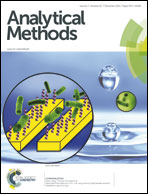Development of a rapid detection method for eight organophosphate esters in plastic samples from automobile interiors using ultra-performance liquid chromatography tandem mass spectrometry with microwave assisted extraction
Abstract
A rapid, effective and eco-friendly method for determination of eight organophosphate esters in plastic samples from car interiors by microwave assisted extraction followed by ultra-high performance liquid chromatography combined with tandem mass spectrometry was established. Acetone/ethyl acetate (3/1, v/v) was used as extractant. Response surface methodology was applied as the experimental design strategy to screen and optimize the extraction variables which affected the extraction efficiency, such as the volume of the extraction solvent, the time for extraction, and the temperature of extraction. Baseline separation of eight OPEs was achieved in 4.5 minutes. The method showed excellent linearity 1–250 μg L−1 for TBEP, TCP, and DPOP; 2–500 μg L−1 for TPhP; 5–1250 μg L−1 for TEP; 10–2500 μg L−1 for TPrP and TCPP; 15–3750 μg L−1 for TCEP (R > 0.9907). For the eight OPEs, the LODs ranged between 0.25 μg L−1 and 5 μg L−1 and the LOQs ranged between 0.5 μg L−1 and 15 μg L−1.


 Please wait while we load your content...
Please wait while we load your content...